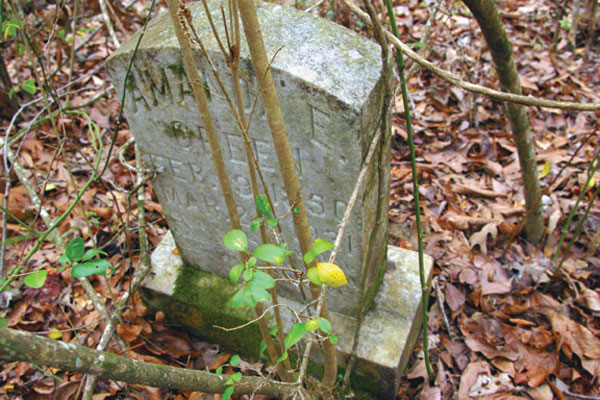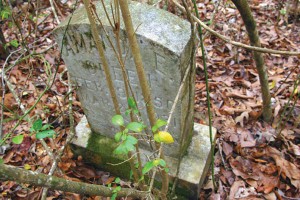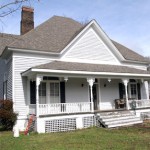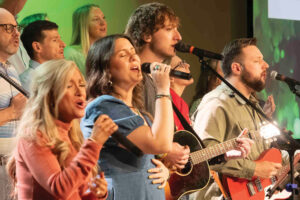
County’s oldest cemetery a little-known find
Story and photos by Jerry Smith
Most of Pell City’s departed are nicely memorialized in several spacious, well-known cemeteries; among them Oak Ridge, the largest; Valley Hill (which lies neither in a valley nor on a hill); New Hope (Truitt); and Mt. Zion. But the city’s original burial ground lies sequestered on an overgrown hillside at the edge of town, known only to a few family members and the historically inquisitive. It seems even the customary cemetery mockingbirds have deserted it.
Donated to the city around 1900 by Pell City’s co-founder, Lydia DeGaris Cogswell, this property provided final repose for a host of Pell Citians during its brief service before the city’s main cemetery was established at Oak Ridge in 1940.
First known as Pell City Cemetery, it was eventually called Avondale Mill Cemetery and the Company Cemetery because so many cotton mill workers were buried there. The Alabama Cemetery Preservation Alliance lists it as Avondale Cemetery aka Village Cemetery. The latest marked burial, William R. Green, was in 1935, although other unmarked graves may have been added since. Oddly, it’s once again called Pell City Cemetery in Mr. Green’s Pell City News obituary.
Over the last few decades the grounds have gradually slipped into a rather gloomy state of upkeep, and thus it remains today. Causey family member Donna Baker says, “… my Father told me the last burial was 1945. He said he used to go with my Grandmother and a lot of other relatives to clean the cemetery every year. He said the last time it was cleaned was in the 1970s.”
It’s hardly recognizable as sacred ground anymore unless one accidentally stumbles over one of the few formal tombstones still standing there. The plot was partly a potter’s field, hosting the remains of an estimated 50 or more local decedents, most of whose survivors could not afford more than a simple fieldstone or diminutive fragment of plain marble to mark their final rests
Unlike other local cemeteries, there’s only a few simple, early-20th-century tombstones with badly eroded lettering and a couple of crude stone surrounds. The only visually imposing grave marker belongs to Dock Causey, placed by Woodmen of the World in 1928.
Sunken graves appear randomly throughout the property. Those who visit here must be careful of tripping over small fieldstone markers hidden under inches of fallen leaves, which leads us to wonder how many others are interred here with no markers at all.
In Pell City’s early days, diseases unfamiliar to most people today took many young lives. In fact, three of the 10 scripted gravestones are for infants of less than one year of age. This is true of most other urban cemeteries of that era, but here we could probably assume that, for every marked infant’s grave, there’s likely to be many more whose parents could not afford a proper stone.
In a St. Clair Times story by Rob Strickland, local historian Kate DeGaris said, “It’s very old and, as I understand it, both black and white people are buried there. The relatively large number of childrens’ graves … can be attributed to health conditions of the early 1900s”.
Mrs. DeGaris continues, “It is known that, periodically, epidemics would come through the area, such as diphtheria, smallpox and typhoid, so I’m not surprised that a lot of children are buried there. …” The sadness deepens as one reads their bittersweet epitaphs, such as: Our Darling Has Gone To Be An Angel or Budded On Earth To Bloom In Heaven.
Indeed, even Nature seems to contribute to the mournful ambience by littering the grounds with fallen cedars and oak limbs whose fibrous cores have eroded over several decades to resemble gaunt, bleached bones.
If ever a local site deserved restoration, this one surely does. Long tree trunks lie across stone walls, some having barely missed tombstones as they fell. Other jagged logs have been pulverized into coarse sawdust and chips by insects, birds and decay. Briers, saplings, even young trees encroach upon almost every marker.
Although a state-required access path has been cleared on the western side of the property, visitors quickly encounter a hazardous maze of prickly Southern foliage and sunken pits. Boots and a walking stick are a must, especially during warmer months when snakes are an assumed peril in such terrain.
To access the site, drive southward from Cogswell on 19th Street to 10th Avenue South. Turn right, then an immediate left onto 18th Place South. Drive to the end of the road and look for a wide path into the woods on your left.
There are “No Trespassing” signs which you should respect unless you have a valid reason for going there. Once onsite, be very careful of rocks, concealed sinks and clinging foliage. Please disturb nothing, take only photos and notes, and leave behind nothing but footprints.
Treat this place as you would the final repose of your own kin. Who knows? Perhaps they are.






























